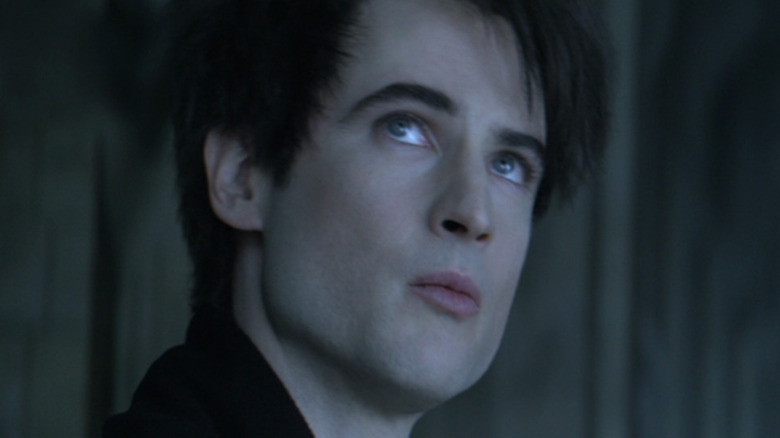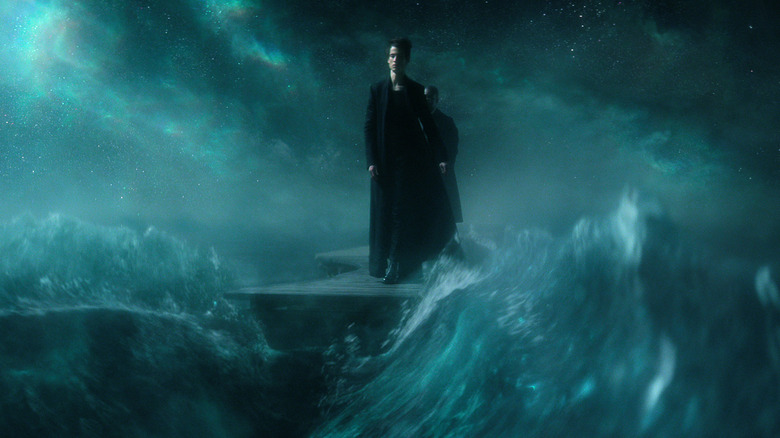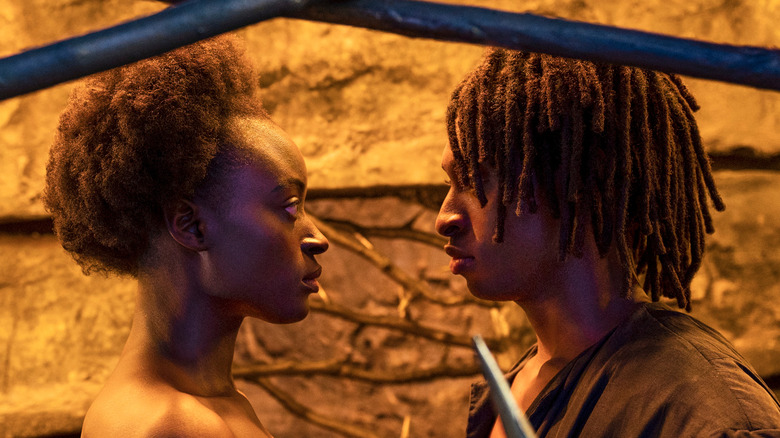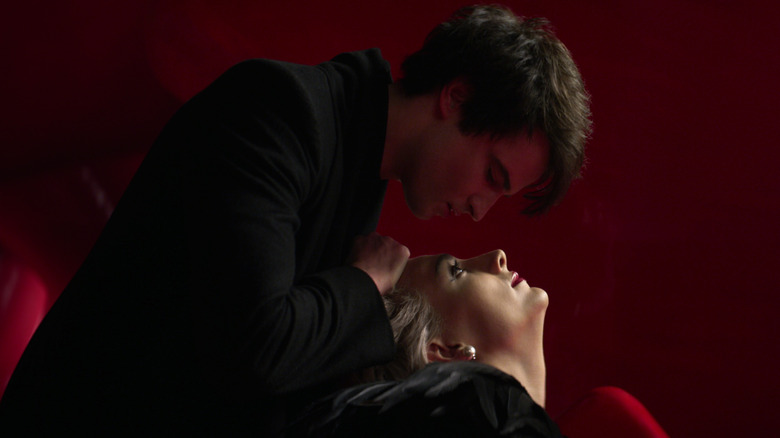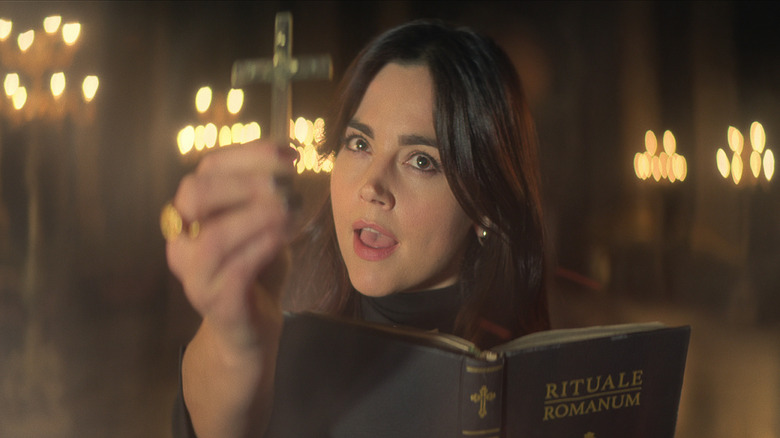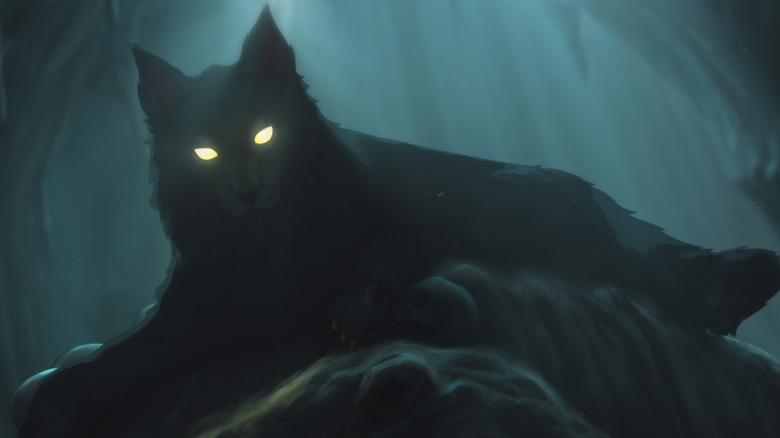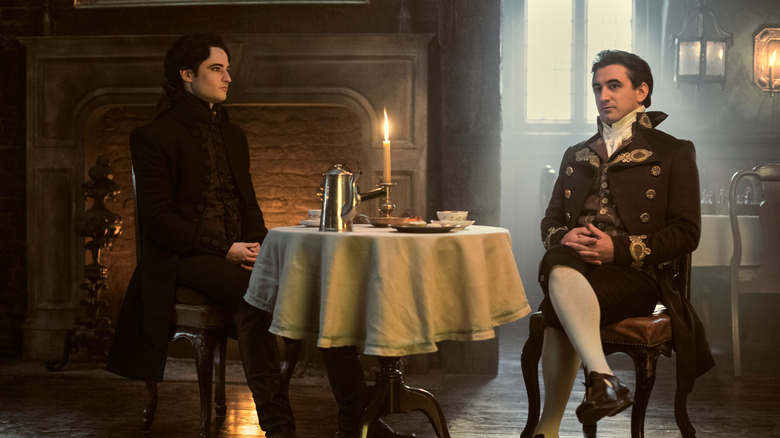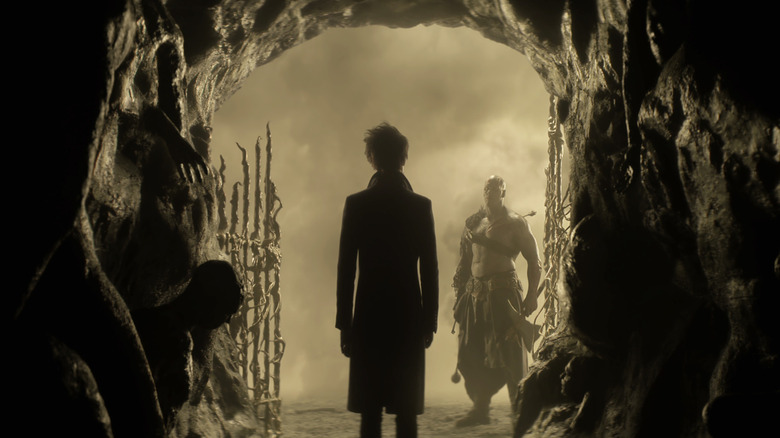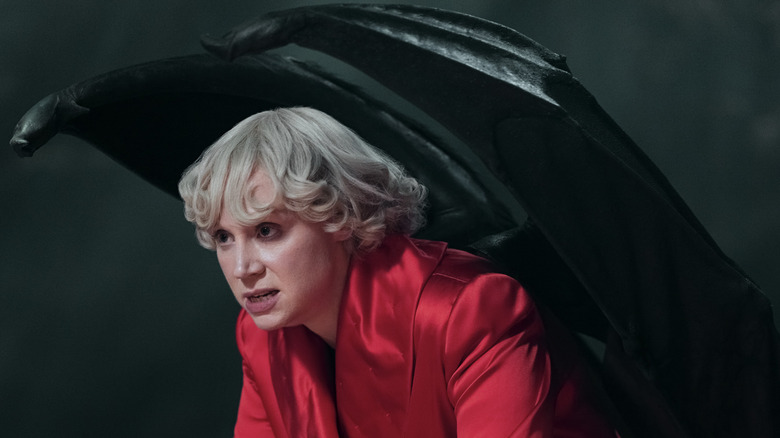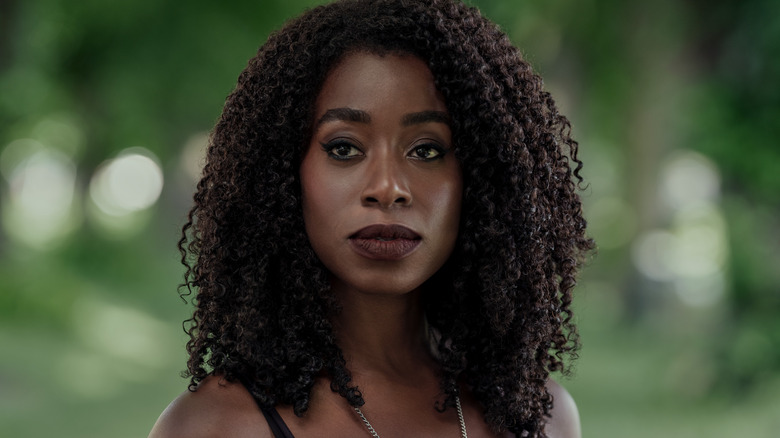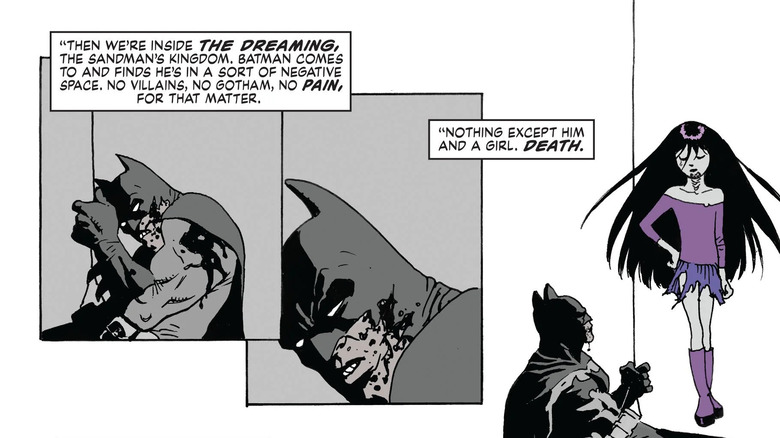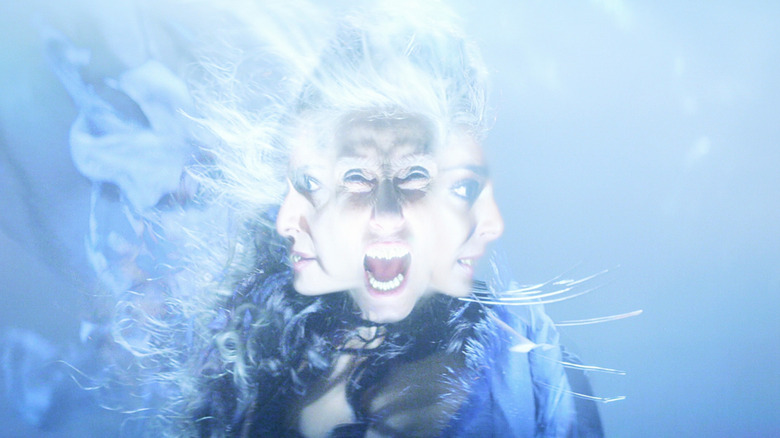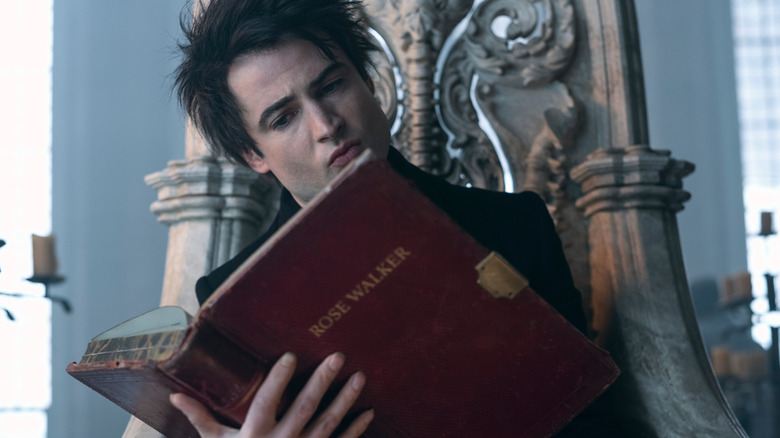12 Things We Want To See In The Sandman Season 2
It took over 30 years for the legendary graphic novel series "The Sandman" to make its way to the screen, but even with three decades of hype to live up to, Netflix's "The Sandman" Season 1 delivered. With overwhelming critical and viewer support, Netflix waited less than two months — still an Endless amount of time for fans — to grant the series a Season 2 renewal. With all the uncertainty behind us, those of us devoted to Dream (Tom Sturridge), Death (Kirby Howell-Baptiste), and the rest of the seven Endless are now free to contemplate all that Season 2 can become. The possibilities are as endless as the series' main characters, but a few potential inclusions loom taller, darker, and more handsome than the rest.
Though the ultimate Destiny of Season 2 is unknown, it does have a vast comic book library to draw upon, with stories to fit every fan's Desire. One of the most appealing aspects of the original series is its vast and inclusive setting, open to any wild Dream conjured up by author Neil Gaiman, and yet it remains permeated in humanity at every point. The graphic novels could tell any story, whether it chronicles the Delirium of mortals, the self-inflicted Destruction of the gods, or even the ultimate Death of a main character. Don't Despair — the next season of Netflix's "The Sandman" is free to do the same. Here, we'll list the 12 things we want to see most in "The Sandman" Season 2.
Massive spoilers ahead for "The Sandman" comics, which could also be spoilers for future episodes of the Netflix show.
The realm of Faerie
Throughout the graphic novels, Dream's adventures take him across time, space, and even into realms outside of either. Amid all that travel, it becomes obvious that Dream (and therefore Gaiman) has his favorite locations. For example, after repeated trips to and from Hell, and similarly numerous visits with Hell's former ruler after they've forsaken their duty, it's obvious that Gaiman has an inescapable fascination with his versions of Lucifer and Mazikeen. However, another realm plays a bigger supporting role than any other, weaving through and under the series like the ever-growing roots of Tír na nÓg trees — the realm of Faerie.
The enchanting plane is first introduced in "A Midsummer Night's Dream," a short story that follows a young Shakespeare debuting his new play of the same name to an audience composed of Faerie's actual residents. We meet Queen Titania, implied to be Dream's ex-lover, and Puck, who comes back later in "The Sandman" to play a part in Dream's death. Before that, Dream takes on a young fairy named Nuala as his ward, and Faerie as a whole plays a major role in Gaiman's spinoff series "The Books of Magic," among other appearances. The magical plane is an important part of Dream's story and one of the earliest windows into the series' lighter, more (literally) spellbinding side, which is why a Season 2 debut could work wonders.
Nada
In Season 1, during Dream's visit to Hell, he happens to pass by one damned, imprisoned soul who calls out his name, though it's not a name we're familiar with. As Dream walks by their cell, he hears "Kai'ckul?" and experiences a rare moment of shock. The speaker, the woman trapped in a thorny prison cell in Hell, is Nada (Deborah Oyelade), and from her brief exchange with Dream — who she sees as Kai'ckul (Ernest Kingsley Junior), the Dream Lord of her culture — it's apparent that the two were lovers. In the 10,000 years since then, Dream has not stopped loving her, and yet still hasn't forgiven her — and for what, we never find out.
Their meeting is as painfully short as it is the regular kind of painful, and it leaves us with 10,000 questions. Though the comic series eventually provides its answers and even a beautiful resolution to the whole tragic affair, the series has yet to do so. Hopefully, Season 2 will change that. Over the course of Season 1, we watch Dream gradually shed his protective patchwork blanket of apathy and wrath and learn to empathize with other beings. But no matter how much kinder he becomes to Lucienne (Vivienne Acheampong), Gault (Ann Ogbomo), or Rose Walker (Vanesu Samunyai), he does nothing to end Nada's eternal suffering. We cannot wait to see why.
The other Endless
Dream spends the bulk of "The Sandman" lacking his full strength. Even in his weakened state, he commands respect and even fear from powerful entities such as nightmares and demons, and even presents enough of a challenge to keep Lucifer Morningstar (Gwendoline Christie) at bay. The Endless are clearly more powerful than most other immortal beings — including many gods — and each of the seven is completely singular in their abilities and influence. They're also, as Desire (Mason Alexander Park) proves in spades (or rather, hearts), absolutely filled with personality and their own, unique ambitions. Naturally, that leaves fans hungering for any additional traces of the siblings, especially the three that have yet to appear on-screen, and we can safely bet that Season 2 will deliver.
All three of the as-of-yet unseen Endless — Destiny, Destruction, and Delirium — are critical components to Dream's journey, both externally and internally, and as such, they're essential to the Netflix adaptation. Dream is a stubborn, unwavering island of a being, and one of his greatest challenges is learning to open himself to change. For him to do so, it will require the extreme examples of Destiny, who never changes, Delirium, who changes constantly, and Destruction, who proves that if they really wanted to, the Endless could quit.
More Johanna Constantine
In this golden age of fandom and cinematic adaptation, there is no longer a dearth of comic book movies, nor even a dearth of separate, alternate adaptations. We no longer have to dream of, say, finally getting a "Spider-Man" movie (Gen Xers and Boomers will understand), nor seeing another interpretation, nor even a third — heck, as of "Spider-Man: No Way Home," all three Spider-Mans have bridged the multiversal and commercial gap and battled their shared rogues' gallery together. That's why the recent, spectacular news that Keanu Reeves' "Constantine" is receiving a sequel can delight fans of the character without detracting from an equally delightful fact — Jenna Coleman's portrayal of Johanna Constantine needs more screen-time.
Coleman knocked it out of the park with her Constantine — a broken mess of a woman with just enough poise and skill to keep the cracks in her veneer subtle. The Constantine character, whether it's John or Johanna, is an intricate assemblage of seemingly disparate pieces, and in the wrong hands, it could easily be done poorly — as evidence, look at the absolute masterwork that is Si Spurrier's characterization in "John Constantine: Hellblazer" and compare it to any number of adaptations in which the character is simply the "brooding monster hunter" archetype. Because Coleman handles the character as deftly as any, she deserves to return in Season 2.
More one-off stories
Shortly after it aired, fans of "The Sandman" Season 1 were treated to the joyous news that it would also contain a secret 11th episode. Unlike the previous 10, the bonus episode consists of two short stories — "Calliope" and "A Dream of a Thousand Cats." Both of these stories appear in the third volume of "The Sandman" collected editions, "Dream Country," alongside two other short stories, "A Midsummer Night's Dream" and "Façade," which raises the immediate question — when will Netflix adapt the other two stories?
As it progresses, the comic series includes more and more (semi-)one-off stories, and by the series' end, these miniatures and asides come to form an ironic throughline for the story. Dream, after all, is the Lord of Stories — the being that shepherds our dreams and inspirations. By showing us some of his stories, Gaiman truly shows us Dream. The many worlds and planes of "The Sandman" influence Dream's story enough to be their own characters — literally, in the case of Fiddler's Green, aka Gilbert (Stephen Fry) — and any adaptation would be hollow without them. If Season 2 tells the missing tales from "Dream Country" or others, it will befit its source material all the better.
More different time periods
One of the greatest gifts that the Endless present from a storytelling perspective is that they're, well, endless. They do occasionally refer to each other as younger and older siblings, suggesting they didn't all spring up at once, but regardless of who followed whom, they're all nearly as old as the universe itself. For the creative team behind Netflix's "The Sandman," that enables them almost total freedom to set their stories when and where they wish.
In one Season 1 sequence, we're treated to the centennial meeting of Dream and the immortal man Robert "Hob" Gadling (Ferdinand Kingsley), which allows us the fun of seeing the pair adapt to the changing centuries. The value goes beyond the humor of Dream wearing period-appropriate garb for each meeting — it also offers context to Dream's journey. In addition, we can't pretend we wouldn't enjoy seeing dinosaurs, Spartans, pirates, and all the other time-travel fare.
The key to Hell
Season 1 features an expertly crafted showdown between Dream and Lucifer — a measured, non-violent battle as tense and enthralling as any massive siege. For Dream, the conflict is simply a necessary risk in order to retrieve his magic helm; for Lucifer, it offers an almost unprecedented opportunity to relish in mischief and machination with genuinely divine stakes. When Dream wins, Lucifer swears that "One day, Morpheus, we will destroy you," and they mean it. But for Lucifer, eternally bored and in desperate need of change, the chance to blend Dream's destruction with some much-needed amusement is too enticing. In the comics, this leads to Lucifer abandoning their duties as Lord of Hell and leaving the kingdom to Dream. It's a gift only to those who don't know better.
Season 2 would do well to include this Trojan Hellhorse as it represents the series at its most subversive and imaginative. Gaiman's Lucifer is brilliant, and knows two things for sure: firstly, that the best way to put Dream on his heels is to surprise him (he, the master of stories), and second, the Key to Hell is as much a curse as a blessing. The following arc in the comics follows Dream's maddening decision in regard to Hell's future, and the chance to see that whimsical agony play out on-screen would be Heaven.
Another chance for Lucifer
We'll start by setting two things straight: the Fox-turned-Netflix series "Lucifer" is a fine show, and Tom Ellis did a commendable job portraying the title character — commendable enough to garner praise from Gaiman himself. And though accuracy in adaptations is secondary to quality, we would be remiss if we ignored how far "Lucifer" strays from its source material — both "The Sandman" series and its phenomenal spinoff "Lucifer" — preventing a more Gaiman-esque Lightbringer from getting their own series.
Just as in the case of Reeves' John Constantine and Coleman's Johanna Constantine, delightfully, there is room for both Ellis' and Christie's Lucifer. However, Christie's Lucifer, or at least a more comic-inspired Lucifer, deserves more. In "The Sandman," just as in "Game of Thrones," Christie manages to stand out among a massive cast, displaying an uncanny ability to command attention and control her environment. For the same reason we would love to see her star in her own spinoff, we would love to see her featured in Season 2 and beyond — we just can't get enough of either Christie or Lucifer.
Continued diverse casting
When the first cast lists for "The Sandman" Season 1 went public, they sparked controversy ... kind of. The controversy wasn't among critics, fans, or fellow creatives, but among a group with very vocal and predictable tendencies, many of whom have never read a comic book in their lives. For this group, any change in characters' skin tones and genders is an unnecessary level of abstraction from the source material that dilutes its core elements. Yet the more accurate take, as argued by Gaiman, artists who designed the original series' characters, and those who knew the real people upon which the characters were based, is that the characters have always expanded representation, dating back to their first appearances. To keep "The Sandman" true to its heart, Season 2 needs to continue with its cleverly diverse casting.
A canonical fact of the Endless is that few ever see them as they are; they see the Endless as they chose to. Over the course of his series, Dream takes on many forms — just check out the jaw-dropping splash pages in "The Sandman: Overture" that feature dozens of species' images of him. The Endless are endlessly mutable. In fact, you could argue that the entire point of his story is to demonstrate that no matter how difficult it may be for some to accept, change is inevitable — and often invaluable.
Let the DC in
We'll be the first to admit this is a tricky one, but it could absolutely be worth the risk. The many characters of "The Sandman" exist under the umbrella of the DC multiverse. No matter how abstract and self-contained they may seem, characters like Dream and Death have appeared in numerous mainstream DC properties, interacting with such flagship characters as Superman, Batman, and Lex Luthor. With the Season 1 inclusion of Constantine, albeit an alternate version, the Netflix series has made it clear that it is willing to let the DC in to some degree. Thus, a tremendous challenge and opportunity facing Season 2 lies in how much DC to let in and crucially — why to let it in.
The tone of "The Sandman" is such that a traditional superhero crossover event would be off-key. Likewise, a deep, dark, metaphysical examination of, say, Superman's psyche, would be similarly grating. But there is a middle ground, and Constantine proves it can be the right path if navigated correctly. The character Swamp Thing, for example, dwells comfortably in both realms, and given the sudden cancellation of Swamp Thing's DC Universe series, fans of DC's darker side would likely be overjoyed to see the Avatar of the Green finally make it on-screen.
The gods
Gaiman does gods right. Whether it's "The Sandman," "American Gods," "Norse Mythology," or even the rare occasions when he gets his hands on a super-heroic adaptation like Thor in "Marvel 1602," the author just gets the gods — insofar as any mortal can. He's somewhat of an expert on world mythology, or at least several notable parts of it, and brings his every insight to bear when turning the numina into narratives. Readers of "The Sandman" comic series will know that droves of deities show up throughout the story's many volumes, playing off of Dream and company in equally numerous ways. With the key to Hell's inclusion a strong possibility for Season 2, the best-case scenario thereafter is for just as many gods to appear in the Netflix series as they do in the comic.
The comics feature appearances by too many deities to list here, but several of the most recognizable from modern society range from Norse Asgardians like Odin, Loki, and Thor, to Egyptian gods like Bast and Anubis, as well as deities from African, Greek, Christian, and Japanese mythologies. For the sake of representation, storytelling, and unabashed fun, let's hope more gods arrive in "The Sandman" Season 2.
Neil Gaiman
Over all else, there's one thing that made the original "The Sandman" comic so special, ensured the audio drama adaptation didn't sacrifice one iota of quality, and enabled a visual adaptation as masterful as Netflix's "The Sandman." That thing is creator Neil Gaiman, and if any one aspect of the series can triumphantly make or tragically break the entire production, it's Gaiman's involvement.
You might think Gaiman's departure from the series to be impossible, and though we might have agreed as recently as one month ago, the recent, shocking departure of Henry Cavill from Netflix's "The Witcher" has forced us to stop taking anything for granted. By all reports, Gaiman is in it for the long haul. He has, after all, tried to bring "The Sandman" to television for around 30 years, and for him to back out now would be the surprise of a lifetime. But television is a commercial enterprise, a massively collaborative effort, and a notoriously fickle mistress. Creators have been fired from their own shows before, and even more have left to pursue other projects. Thankfully, "A Dream of a Thousand Cats" proves that if enough people dream of something, it becomes true, so there's a good chance that we'll see Gaiman back for a stellar Season 2 of "The Sandman."
